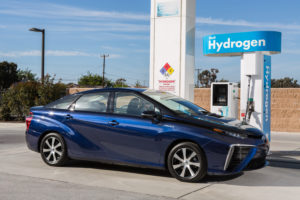EPRI, Other Industry Stakeholders Examine Hydrogen’s Potential to Support Grid and Power Plant Operators
Grand visions of hydrogen for power generation come and go. A turn-of-the-century surge was epitomized by Jeremy Rifkin’s 2002 best seller, The Hydrogen Economy, which highlighted hydrogen’s revolutionary potential, without a clear-eyed view of the obstacles. Momentum in the 2000s met strong headwinds with the Great Recession and subsequent budget battles.
The latest resurgence of interest in hydrogen arrives with a more practical approach to its role in energy’s future.
“Researchers are taking another look at hydrogen,” said Brittany Westlake, energy scientist in EPRI’s Energy Storage and Distributed Generation Program. “The U.S. Department of Energy’s National Laboratories are assessing hydrogen on the scale of the energy system as a whole, primarily as a storage vehicle to help balance the grid. There is traction in Europe, especially as storage to complement renewables, and Asian automakers are investing in the early stages of commercialization of fuel cell electric vehicles.”
Why Hydrogen?
The vision and potential remain appealing. Hydrogen is the most abundant element in the universe, but it doesn’t exist naturally on earth as a free-form gas. It is bound with oxygen as water and with carbon as hydrocarbons. The practical issues remain: how to produce or extract it economically and safely, store it, distribute it, and use it. Environmental benefit is hydrogen’s great allure: when either burned or oxidized through a fuel cell, the only emission is water.
Two pathways for producing hydrogen gas are reacting steam with natural gas (or gasified coal) and electrolysis (splitting H2O, or water, with electricity). The first path is well-established in the chemical industry. The second path is about 1.5 times more expensive and is used sparingly. Compression of hydrogen gas to liquid form requires cryogenic processes (at -253°C). Because pure hydrogen embrittles metal, storage tanks are made of composites.
A driving force in the renewed interest in hydrogen is its scalability for bulk storage. Current battery technologies don’t lend themselves to bulk storage as do pumped hydroelectric storage or compressed air energy storage, but both of these are capital-intensive. Hydrogen, stored in volume, offers a third alternative for bulk storage.
On a smaller scale, hydrogen storage could smooth the variability of wind and solar generation, using the excess electricity to generate hydrogen. “The same way we refine millions of gallons of gasoline a day, we could potentially produce millions of kilograms of hydrogen from renewable generation,” said Westlake.
Also driving hydrogen research is its potential for co-production with fossil or nuclear generation. “Underutilized generation assets could produce hydrogen in off-peak hours, lifting capacity utilization of existing equipment,” said Westlake.
Nuclear power plants have historically operated as baseload units as a result of their low fuel costs. With increasing grid variability, some nuclear operators are faced with flexible plant operations. They are interested in studying the feasibility of using electricity generated during periods of low demand to produce hydrogen and minimize cycling.
Prospects in Europe
A recent EPRI report assesses hydrogen’s potential in Europe, finding that established, traditional supply chains and surplus industrial hydrogen “could be a key source during the transition to a hydrogen economy.” Current production is nearly 7 million tons per year, with more than 99% used for petroleum refining and ammonia production.
With respect to hydrogen use in transportation, the consensus is that it will require sustained, significant R&D investment to improve performance and to reduce the cost of fuel cells. Establishing a fueling infrastructure will be formidable, with only about 100 hydrogen fueling stations in the European Union.
“The outlook for green hydrogen [hydrogen coupled with renewables] in Europe remains highly uncertain,” said the report. “With the right conditions in place, green hydrogen could account for 15% of Europe’s hydrogen demand by 2030, up from less than 1% today.”
Fuel Cell Vehicles in the United States

Asian automakers—notably Toyota and Hyundai—are making a concerted effort to create a global pathway for fuel cell vehicles. Toyota introduced the Mirai in the California market in 2015. It sells for about $65,000, and as an inducement Toyota offers an eight-year/100,000-mile warranty, along with free fuel for three years.
The U.S. Department of Energy estimates that about 300 fuel cell vehicles have been sold in the United States, with 31 public hydrogen fueling stations primarily clustered in the San Francisco Bay Area and Los Angeles.
EPRI’s Hydrogen Research
EPRI is pursuing several projects related to hydrogen storage and distributed generation, with its researchers assessing the prospects of polymer electrolyte membrane fuel cells and fuel cell electric vehicles. EPRI’s Generation and Nuclear sectors are exploring how hydrogen production and co-production could increase the operational flexibility of new and existing power plants.
“We see great potential for hydrogen, especially as a storage medium supporting renewable generation, and through co-production increasing the operating capacity of fossil plants,” said Westlake. “As a bulk storage option, hydrogen could contribute to system flexibility and grid stability. This is one of the reasons utility members have shown growing interest in recent years.”
But Westlake cautions that many technical, economic, logistical, and marketing obstacles remain. “We’ve learned not to promise the moon. Nevertheless, hydrogen has a unique potential, and the U.S. Department of Energy recognizes that this will be a long-term trajectory well worth the R&D investment.”
EPRI Technical Expert:
Brittany Westlake


